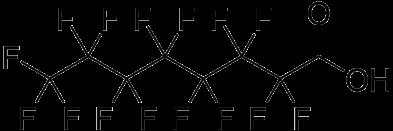
26 minute read
Dealing With Widespread Perand Polyfluoroalkyl Substances Contamination—Mark D. Miller, David D. Peters, and Evan Ghidella
FWRJ Dealing With Widespread Per- and Polyfluoroalkyl Substances Contamination
Mark D. Miller, David D. Peters, and Evan Ghidella
Advertisement
Since May 2016, when the U.S. Environmental Protection Agency (EPA) issued a lower drinking water health advisory level of 70 ng/L for combined perfluorooctanoic acid (PFOA) and perfluorooctane sulfonic acid (PFOS), two per- and polyfluoroalkyl substances (PFAS), a quiet city in Florida has been dealing with the challenges of widespread PFAS contamination.
Groundwater and soil contamination, primarily due to the use of aqueous filmforming foams (AFFF), which are used for firefighting, has forced the City of Stuart (city) to shut down some of its primary supply wells. Studies were immediately conducted and pilot testing was performed using granular activated carbon (GAC) and ion exchange (IX), resulting in the installation of a treatment system to remove PFAS down to nondetect levels from all groundwater supply wells.
Construction of a 4 to 8 mil-gal-per-day (mgd) IX system, partially funded by State Revolving Fund (SRF) loans, was completed in early June 2019 and is undergoing full-scale testing using multiple types of IX resins and GAC mixes. Coupled with constantly changing regulations, the city continues to deal with cleanup of the AFFF and other contributing sources of contamination, including an unlined landfill and several industrial activities with other historical contaminations.
Along with developing state regulations for PFAS contamination, which were never established prior to 2018 for PFAS in groundwater or soils, the challenges of changing regulations have forced the city to address a multitude of contamination sources and implement the best currently available technologies to deal with these contaminations.
This article will discuss some of the PFAS history, regulations, and lessons learned from a full-scale pilot project for the potable water supply system, including the following: S PFAS Sources S Health Risks From Exposure S Exposure Entry Routes • Release of AFFF • Industrial • Groundwater - drinking water supply • Treated wastewater - public access reclaimed water • Stormwater runoff • Land application - biosolids • Food packaging S Regulatory Review • Current regulations (Florida and other states) including Unregulated
Contaminants Monitoring Rule (UCMR) program • Proposed and potential future regulations • EPA action plan (March 2019 update) review S Treatment and Removal Technology
Overview, Including IX, GAC, and Reverse
Osmosis (RO) S Pre- and/or Post-Treatment Opportunities S Lessons Learned From Full-Scale Pilot
Testing - Multiple IX and GAC Types Used
Background
The PFAS are an environmentally persistent group of man-made chemicals that are found in various types of water sources all over the world, including tap water. These chemicals have been used in a wide variety of industrial and consumer products, including the aforementioned AFFF, as well as paper and cardboard coating materials
PFOA
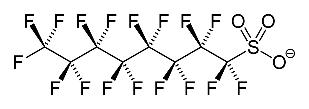
PFOS
Mark D. Miller, P.E., is senior vice president, and Evan Ghidella, E.I., is an analyst, with Kimley-Horn and Associates Inc. in West Palm Beach. David D. Peters is public works director with City of Stuart.
employed in food packaging, ScotchGard TM , and Teflon TM . Drinking water is one route of exposure that may have led to increased concentrations in the blood serum of humans in most developed countries (USHHS, 2009), but some of these compounds, such as PFOA and PFOS, have also been detected in the blood of animals in remote regions of the world. The PFOA and PFOS are two of the most-studied, and, therefore, regulated, PFAS compounds, and belong to the perfluoroalkyl acids (PFAA) family. The PFAA are stable chemicals made of a carbon backbone surrounded by fluorine atoms and an acid group located at the end of the carbon chain, as shown in Figure 1.
There are many sources of PFAS compounds, all man-made formulations of fluorinated compounds developed in the early 1950s, which continue to be manufactured to this day. A brief history of the development of these chemicals, and how they affect humans, is provided in Table 1.
Exposure Entry Routes
There are a number of pathways through which PFAS contamination of humans can take place, including diet, drinking water, food contact materials, nonfood personal items, and indoor and outdoor air. Although a number of authors have attempted to calculate the contribution of these individual pathways to total contamination, the available data records are not presently adequate to allow sound conclusions to be drawn. There is, however, a general consensus that dietary uptake represents the largest contribution.
In recent years, the biological properties of PFAS have been detailed in numerous publications; however, these are generally limited to PFOA and PFOS. These two substances are mostly the only PFAS that have been toxicologically examined in animal studies that would allow conclusions to be drawn about
potential human toxicity. Data on short-chain PFAS that are apparently being substituted for longer-chain molecules in industrial processes are only of a fragmentary nature.
Because of their solubility in water and the increasingly wide spectrum and volume of their use, these short-chain PFAS are starting to receive considerable study. This is particularly evident since they appear to be ubiquitously distributed throughout the water pathway and can thereby lead to an increased background contamination of the environment. Additionally, PFAS are being used in mixtures with varying compositions, making toxicological evaluations much more difficult. For this reason, standardized in vitro and in vivo methods should be used and further developed to allow reliable conclusions to be drawn concerning the toxicity of the individual substances, as well as of various PFAS mixtures. Consequently, an adequate toxicological evaluation of the total situation is presently not possible.
The PFAS are distinct from other persistent and bioaccumulative organic compounds because of their importance as drinking water contaminants. The PFAS exist predominantly as an anion under environmental conditions, do not bind well to soil, migrate readily from soil to groundwater, and are highly water soluble (Davis et al., 2007). These properties of PFAS differ from those of other persistent and bioaccumulative organic pollutants, such as polychlorinated dioxins and furans, polychlorinated biphenyls (PCBs), and pesticides, like chlordane and dichloro-diphenyl-trichloroethane (DDT). These other compounds are generally not significant as drinking water contaminants because they have a high affinity for soil and sediments, but low water solubility.
The PFOA that is specifically released into the environment can contaminate surface water and groundwater used as sources of drinking water. Sources of PFOA in the environment include discharge to air and water from industrial facilities, where it’s made or used; release of AFFF, particularly at military sites, airports, and firefighter training facilities; disposal in landfills; discharge from wastewater treatment plants treating domestic and/or industrial waste; street runoff; stormwater runoff; land application of biosolids (sludge) from wastewater treatment plants treating industrial waste (Clarke and Smith, 2011; Lindstrom et al., 2011b; Sepulvado et al., 2011); land application of wastewater from industrial sources (Konwick et al., 2008); and use of contaminated industrial waste as a soil amendment (Skutlarek et al., 2006; Hölzer et al., 2008).
As is the case for other groundwater contaminants, PFAS can reach drinking water wells via the well-established pathway of migration of a groundwater plume that has been contaminated either directly from surface spills or by contaminated surface water mixing with groundwater drawn in by pumping wells. Unlike many other environmental contaminants, PFAS can also reach groundwater from air emissions from nearby industrial facilities, followed by deposition from air onto soil, and migration through the soil to groundwater (Davis et al., 2007).
In West Virginia and Ohio, drinking water wells as far as 20 mi away were contaminated with PFOA by releases from an industrial facility, where it was used as a processing aid in fluoropolymer production. Groundwater contamination occurred via soil deposition Continued on page 30
Table 1. Development and Regulation Timeline for Per- and Polyfluoroalkyl Substances
1947
1951
1970
2000
2001
2006
2009
2009
2012
2015
2016
2016 3M manufactures PFOA.
Dupont develops Teflon. U.S. Air Force beginsusing AFFF to fight fuel fires. 3M begins phase-out of 13 PFAS, including PFOA andPFOS. Dupont issues consent decree in West Virginia and Ohio. Global stewardshipaddresses issue, with voluntary manufacturer reduction in 2006, 95 percentremoval by 2010, and elimination by 2016. Provisional health advisory level (HAL) forPFOA/PFOS set at 0.4/0.2 ug/L. Superfund soil screening levels set at 60/6 mg/kg. C8 Science panel links probable cancer to PFOA. Hoosick Falls, N.Y., issuesdo not drink order. Food andDrug Administration (FDA)no longer allows PFOA andPFOS to be added to food packaging. EPA lifetime HAL advisories of 0.07 ug/L set for PFOA and PFOS.
Table 2. Contaminants of Concern: City of Stuart Wells
Water Quality
Parameter
PFAS (PFOS)*
PFAS (PFOA)**
PFAS (PFOS + PFOS) (max) > 1,4-Dioxane** > Methyl-tert-butyl-ether > cis-1,2-Dichloroethylene (DCE) > 1,2 Dichloropropane (DCP) > 1,2,3-Trichloropropane (1,2,3-TCP)* > Trichloroethylene (TCE) > Tetrachloroethylene (PCE) > Vinyl Chloride > Chlorobenzene > Benzene
* UCMR 3 List ** UCMR 3 and UCMR 4 List >Treatment currently in place
Unit Influent (range)
ug/L ug/L ug/L ug/L ug/L ug/L ug/L ug/L ug/L ug/L ug/L ug/L ug/L 0.051 - 0.470 0.014-0.052 0.050 - 2.15 0.130 1.800 0.3-42.4 1.2-39.0 1.0-23.8 5.00 0.65 0.13 0.34 1.30
MCL/HAL
- - 0.070 - - 70.0 - - - 3.0 1.0 - 1.0
Continued from page 29 of PFOA that had been emitted into the air followed by migration to groundwater, and, to some extent, recharge of the groundwater aquifer with contaminated surface water from the Ohio River (Steenland et al., 2009a; Shin et al., 2011). The PFOA was detected in public water supply wells in this vicinity at levels up to > 4000 ng/L (DuPont and URS Diamond Corporate Remediation Group, 2008) and in private wells at up to > 13,000 ng/L (Hoffman et al., 2011).
In New Jersey, PFOA was detected at up to 190 ng/L in shallow unconfined wells of a public water supply located near an industrial source (Post et al., 2009a), and at > 40 ng/L, with a maximum above 400 ng/L in 59 of 104 private wells within a radius of slightly more than 2 mi of this facility (DuPont, 2009). Contamination of the distant wells was likely due to air deposition (Post et al., 2012).
The PFAS may also enter the body by ingestion of dust and dirt particles and by contact with products that have been treated with substances that contain PFAS or their precursor compounds, which may include carpets, upholstered furniture, or textiles. These routes of entry may be of particular importance regarding the toxicology of perfluorinated compounds in children because contact can occur indirectly by hand-to-mouth transfer or directly to the mouth if an infant sucks on the product.
Another route that must be considered is inhalation of PFAS in indoor or outdoor air, as well as the inhalation of waterproofing sprays.
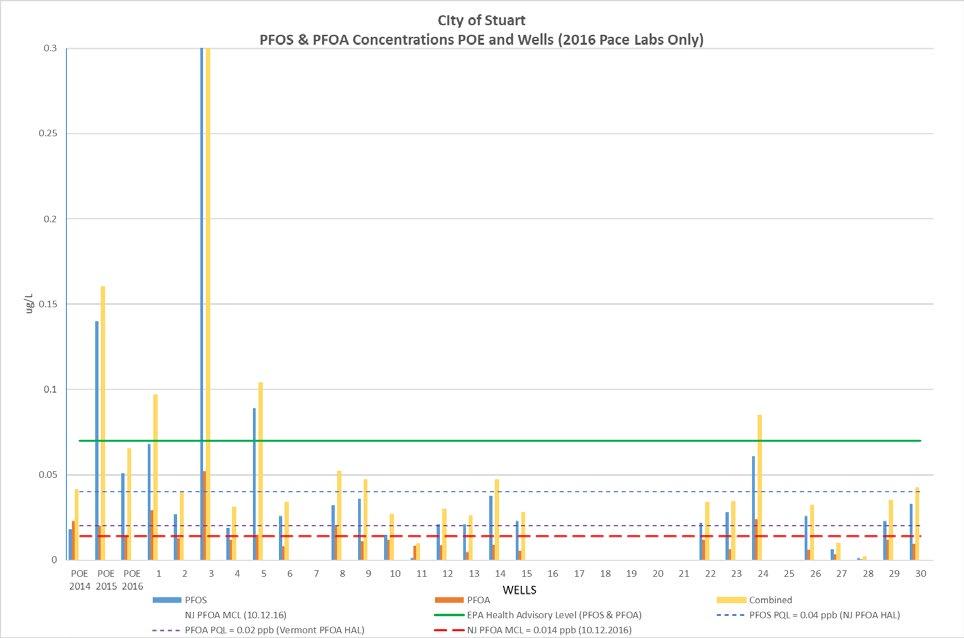
Dermal exposure may also occur by skin contact with PFAS-treated products.
Occurrence in Drinking Water
The PFOA and other PFAS occur in raw and finished drinking water from both groundwater and surface water sources in other parts of the United States and other nations around the world (reviewed by Mak et al., 2009; Post et al., 2012; Post et al., 2013). The PFAS are found in drinking water impacted by discharges from industrial facilities, release of AFFF, and other known sources of contamination, as well as where the source is unknown (Post et al., 2012).
The PFAS have been detected at high frequency in some river basins that are important sources of drinking water. For example, it was detected (> 1 ng/L) in 82.3 percent of samples from 80 locations throughout the Cape Fear River (N.C.) drainage basin (population of 1.7 million), at a median of 12.6 ng/L and a maximum of 287 ng/L (Nakayama et al., 2007). In the Upper Mississippi River drainage basin in the midwestern U.S. (population of 30 million), it was detected (> 1 ng/L) in 73 percent of 88 locations, with a median of 2.07 ng/L and a maximum of 125 ng/L. In the Tennessee River in Alabama, PFOA levels were 395+128 ng/L in samples from the 35 river mi downstream of the site of discharge from a fluorochemical manufacturing facility, with the highest levels (521-598 ng/L) in the 6 river mi furthest downstream (Hansen et al., 2002).
In Germany, PFOA and other PFAS in organic material, which were applied to agricultural land, contaminated the Moehne and Ruhr Rivers, important sources of drinking water. The PFOA was detected at up to 33,900 ng/L in a creek near the site of contamination upstream of these two rivers, and at up to 519 ng/L in drinking water from the Moehne River (Skutlarek et al., 2006).
The PFAS are not effectively removed from drinking water by conventional treatment processes, such as coagulation/flocculation, sand filtration, sedimentation, mediumpressure ozonation, aeration, chloramination, and chlorination; the PFAS can, however, be removed from drinking water by GAC or RO (Rumsby et al., 2009; Bartell et al., 2010a; Tagaki et al., 2011; Eschauzier et al., 2012; Appleman et al., 2014; DWQI, 2015b). Unless specific treatment for removal of PFAS is in place, concentrations of PFAS detected in raw drinking water can be considered to be representative of concentrations in finished drinking water.
Health Risks From Exposure
The PFAS are found in a wide range of consumer products that people use every day, such as cookware, pizza boxes, and stain repellants; therefore, most people have been exposed to them. Certain PFAS can accumulate and stay in the human body for long periods of time. There is evidence that exposure to PFAS can lead to adverse health outcomes in humans. The most-studied PFAS chemicals are PFOA and PFOS and it’s been shown that they can cause reproductive and developmental, liver and kidney, and immunological effects in laboratory animals. Both chemicals have also caused tumors in animals.
The PFOA and PFOS are linked to a number of health effects, including: S Liver damage S Kidney damage S Increased cholesterol levels S Pregnancy-induced hypertension S Certain types of cancer and increased risk of thyroid disease S Increased risk of decreased fertility S Increased risk of asthma diagnosis S Decreased response to vaccines
The EPA acknowledges that associations of PFOA and numerous health endpoints are observed in these human populations and that associations with some effects have consistently been found in multiple human studies. Some states, however, have established some of their own criteria, and have established lower thresholds that they believe are more protective of public health.
New Jersey, for instance, established a Drinking Water Quality Institute (DWQI) Health Effects Subcommittee to pursue development of a maximum contaminant level
(MCL) recommendation for PFOA on Jan. 27, 2009, based on its potential health effects and its occurrence in New Jersey public water supplies. The EPA states that, while these human studies are useful for hazard identification, they cannot be used quantitatively because the PFOA exposures at which the associations were observed are unknown or highly uncertain. Although the subcommittee agreed that the human data have limitations that preclude their use as the primary basis for risk assessment, it does not agree with EPA that the serum PFOA concentrations and PFOA exposures associated with human health effects are highly uncertain or unknown.
Several health effects, some with evidence supporting multiple criteria for causality, are associated with PFOA exposures at serum levels well below those that would result from exposure to 70 ng/L in drinking water. The subcommittee therefore concluded that elevations in serum PFOA levels of the magnitude expected from ongoing exposure to 70 ng/L (EPA Health Advisory) in drinking water are not desirable and may not be protective of public health.
New Jersey therefore established much lower criteria as listed:
14 ng/L – Health-based MCL recommended by DWQI Health Effects Subcommittee 40 ng/L – N.J. Department of Environmental Protection (DEP) drinking water guidance (2007) based on older toxicology data 70 ng/L – EPA lifetime health advisory
Regulatory Review
The widespread detection of these chemicals and their persistence in the environment led EPA to establish provisional health advisory (PHA) values for PFOA and PFOS of 0.4 and 0.2 ug/L, respectively, and PFOA and PFOS were added to the EPA Contaminant Candidate List 3 (CCL 3) published in October 2009 (EPA, 2009). Six of the perfluorinated compounds were also added to the EPA UCMR 3. As a result of this testing, and with some of the history and health risks associated with PFAS compounds, EPA greatly reduced the health advisory levels in May 2016 and issued a provisional health advisory of 0.07 ug/L for combined PFOS and PFOA.
The UCMR 4 is currently underway, but does not include any of the PFAS family of contaminants. The UCMR 4 was published in the Federal Register on Dec. 20, 2016. The UCMR 4 requires monitoring for 30 chemical contaminants between 2018 and 2020 using analytical methods developed by EPA and consensus organizations. This monitoring provides a basis for future regulatory actions to protect public health.
The EPA is considering UCMR 5 to be
Figure 3. Breakthrough curves at different resin depths versus bed volumes.
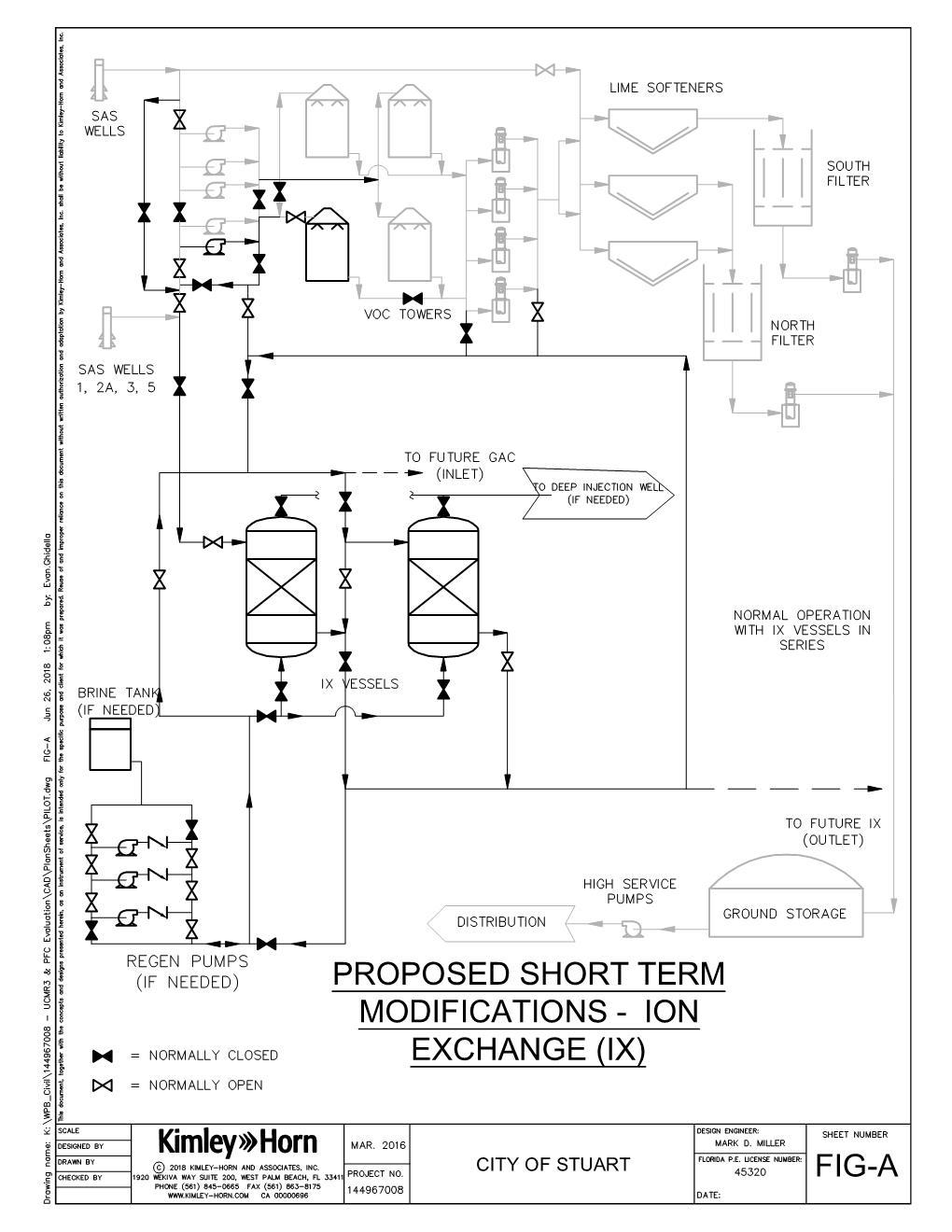
conducted similarly to previously unregulated Approach contaminant monitoring cycles every five years. In addition to PFAS compounds monitoring, The city’s existing groundwater supply seven specific PFAS analytes were nominated had limitations due to challenges with other on the CCL 5 for consideration in UCMR 5. historical contaminants, including the presence Relative to the priority for PFAS compounds of PFAS and some of the emerging contaminants to be included, EPA officials indicated that they of concern. Accordingly, the approach to the would be awaiting input to assist the agency in city’s water supply concerns revolved around making decisions on priority for monitoring. achieving compliance for the existing water The EPA noted that the agency did not have source and customers, as well as a sustainable health advisories for many PFAS compounds, supply for the city’s future. but that did not preclude the agency from The short-term solution involved analyzing, monitoring them under UCMR 5, which would selecting, and implementing the treatment be useful in developing such advisories. The technologies available to treat and remove the UCMR 5 monitoring would begin in January currently present PFAS from the produced 2023 and be completed by 2026. Continued on page 32 Florida Water Resources Journal • August 2020 31
Continued from page 31 water prior to distribution. The focus of this evaluation supports the short-term alternatives available to achieve such treatment and enable the city to achieve compliance. The goals for the short-term evaluation included the paramount compliance with UCMR regulations, followed by minimizing the capital and operation expenses for the short-term solutions.
The long-term approach involved implementing a consistent and reliable treatment method to remove emerging contaminants or securing a sustainable water source free of contaminants beyond traditional salinity and organic contaminants.
The current water supply is derived from the surficial aquifer, which has limited withdrawal capacity and is highly scrutinized by the South Florida Water Management District (SFWMD) due to its influence on the surrounding water table. In addition, its close proximity to the surface yields it as suspect to contamination from
Figure 4. Granular activated carbon versus ion exchange.
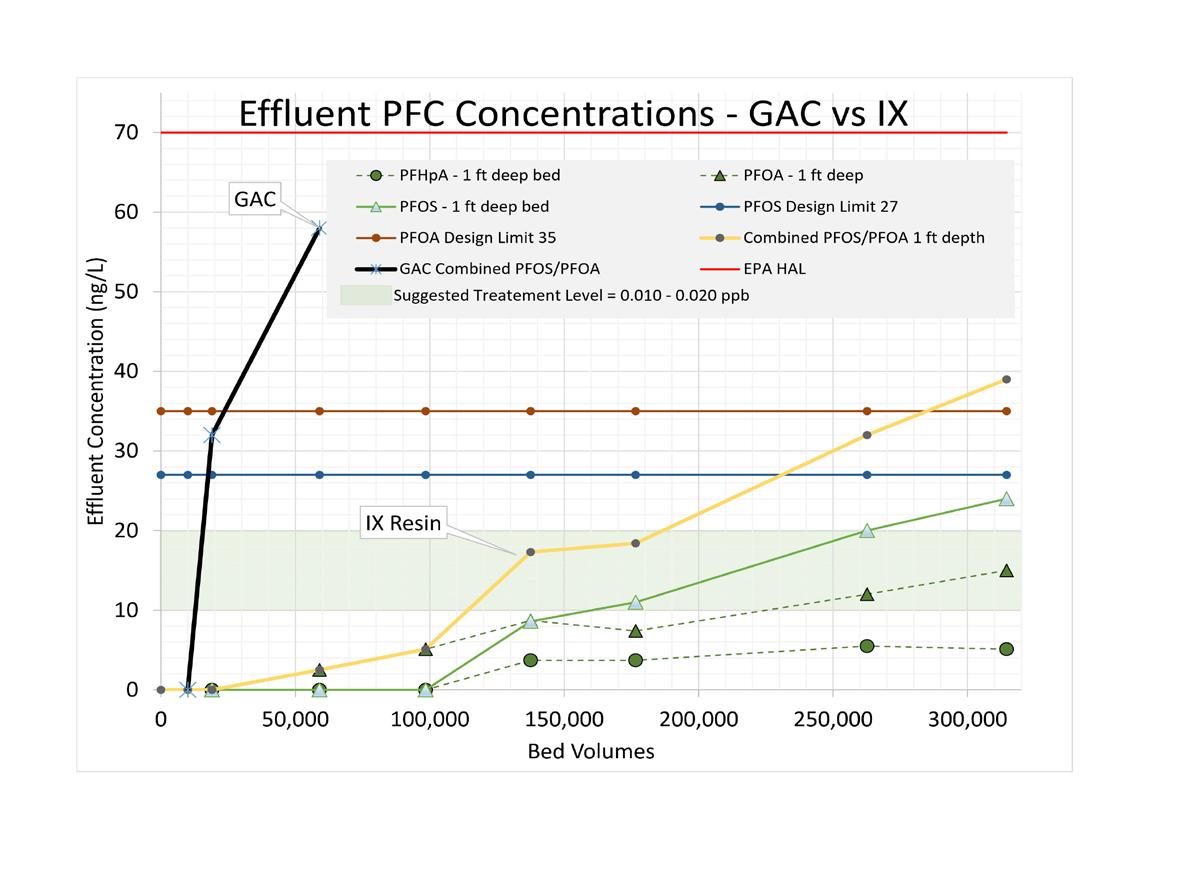
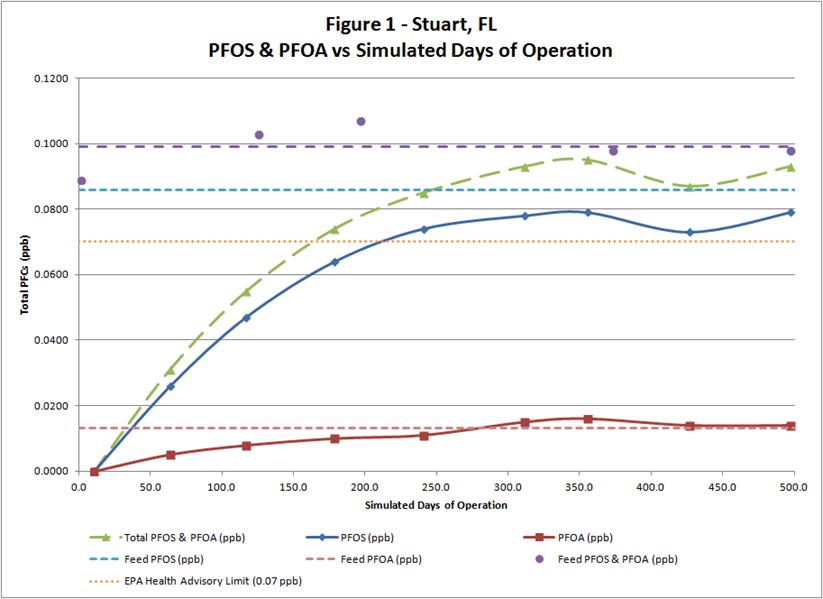
surface application of chemicals and reclaimed water. Specifically, these contaminants include the PFAS and others, which are listed in Table 2. This evaluation addresses the desktop analysis of multiple treatment alternatives.
Longer-term raw water supply focused on alternative water sources that should be evaluated in the future for sustainability, treatment feasibility, regulatory considerations, and financial efficiency for the city. Alternative water sources that were identified can be used as the sole source of supply water, or used in combination with the existing surficial influenced wells or another alternative supply. Once one or multiple sources are identified and committed, treatment pilots should be engaged to demonstrate successful treatment, as well as operational feasibility, to support operational commitments to the city’s utility staff and financial resources.
The existing surficial aquifer is a limited source of raw water, and the city does not have any alternative water supply sources other than interconnects with neighboring utilities. Additionally, the existing surficial aquifer has a number of existing contaminants that further limit the withdrawal capacity and, with the recent discovery of PFAS contaminants, further limits the utility’s ability to meet future water system demands and drinking water standards. Table 2 provides a list of current and historical known contaminants that require advanced treatment beyond conventional lime softening and filtration.
Prior to 2019, there was no known groundwater contaminant level established for PFAS that would trigger corrective cleanup actions or potential funding at the PFAS levels measured in the wells. Additionally, the use of reclaim water for irrigation and continued recharge of the surficial aquifer has no regulations for these emerging contaminants; however, reclaim water quality standards are currently under review by the regulatory agencies, which may trigger monitoring and/ or potential treatment for these emerging contaminants. Subsequently, the city’s actions should address these contaminants in both the drinking water and potential discharge to the wastewater treatment system to minimize any discharge of these contaminants to the environment.
The short-term solution should include either replacing lost capacity from these wells with finished water from existing finish water interconnects, or restoring the functional use of the existing groundwater wells containing elevated PFAS levels with an alternative treatment method. Restoring capacity of the raw Continued on page 34
Continued from page 32 water supply wells containing PFAS levels above the HAL must include an advanced treatment method not currently used at the existing facility. Pilot testing using the most cost-effective, bestknown track record of reducing PFAS was developed and implemented to identify design criteria, operational experience, and capital and operating costs associated with the selected treatment option.
The existing treatment system provides conventional treatment, consisting of aeration
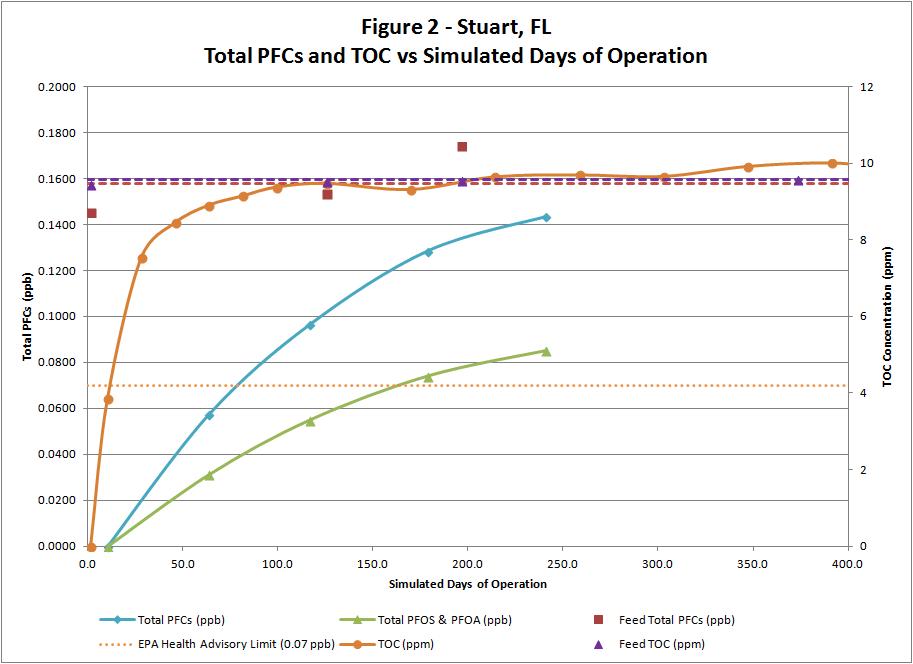
and air stripping of volatile organic compounds, lime softening, filtration, and disinfection. Conventional filtration and lime softening have limited effectiveness removing PFAS found in the raw water. It’s also evident from the water quality test results taken at the point of entry (POE) and individual wells that PFAS are unaffected through the existing treatment plant. Figure 2 depicts PFOA and PFOS levels in all of the wells, as well as at the point of entry, indicating that the existing conventional treatment system is ineffective at removing these
Figure 6. Perfluorinated chemicals and total organic carbon versus simulated days of operation. constituents. As such, conventional treatment is not an option for continued treatment and reduction of these emerging contaminants; therefore, alternative treatment options were researched and evaluated that would effectively remove these contaminants in a cost-effective manner.
Viable treatment methods known at the time to be effective at removing PFAS include: 1. An ion exchange (AIX) 2. GAC 3. Membrane treatment: RO and nanofiltration (NF) 4. Other treatment methods: chemical oxidation/reduction, thermal and electrochemical, biological
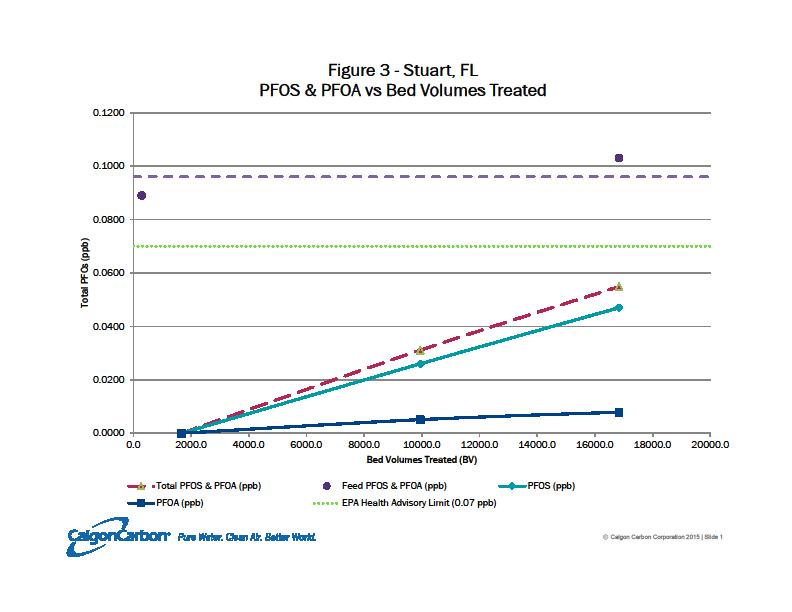
Based on the research, literature review, and discussions with manufacturers, sorption processes (such GAC and AIX) and membrane treatment provide the most-effective removal of PFAS from water streams. Chemical oxidation, advanced oxidation and reduction processes, and thermal and electrochemical processes are processes that show promise, but many of them are still in the research mode, have limitations, and have no full-scale track record. Each one is site-specific and may be complementary and more effective as combined systems, but may be more suitable in wastewater streams where other interferences exist. These treatment methods were not evaluated further due to their more research-driven techniques and limited fullscale installations that exist for the treatment of groundwater.
The primary treatment goal is to remove the PFAS from the raw water, followed by reduction or removal of other known contaminants and upcoming UCMRs that may be of concern. The other volatiles and contaminants listed in Table 2 are the secondary goal of implementing a new treatment process.
Total organic carbon (TOC) reduction with a new treatment process is also a benefit that would improve the disinfection byproduct results in the finish water. The benefit of reducing TOC levels has a two-fold effect: addressing the short-term treatment goals, and allowing longterm continued use of the system.
Ion Exchange
The IX is an exchange of ions between two electrolytes, or between an electrolyte solution and a complex solution. Typical ion exchangers are IX resins (functionalized porous or gel polymer), zeolites, montmorillonite, clay, and soil humus. Ion exchangers are either cation exchangers that exchange positively charged ions (cations) or anion exchangers that
exchange negatively charged ions (anions). Typical ion exchangers include softeners that replace or remove calcium (hardness) with sodium.
The IX resins from different manufacturers tend to deliver varying results on PFAS removal. Research indicates that fresh resin presents higher removal efficiency than continuous regeneration approaches (Appleman, 2012). The removal efficiency is estimated to be largely based on molecular weight of the carbon chains. The longer chains, such as PFOS, typically have better removal efficiency in cases where IX has been shown to provide some removal of the PFAS.
Generally, in the cases where IX has provided some level of removal, the smaller versus larger carbon chains were removed at approximately 46 and 92 percent, respectively (Appleman, 2012). According to the 2016 Water Research Foundation (WRF) Web Report #4322, “Treatment Mitigation Strategies for Per- and Polyfluoroalkyl Substances,” Amberlite IRA-400 resin was found to have a higher capacity than GAC for both PFOS and PFOA removal. The contact times for IX, however, are much longer than typical bed volumes used for conventional IX treatment, and conventional regeneration techniques were not sufficient to regenerate the resins.
Other studies have indicated waters contaminated with PFAS that contained higher nominal organic matter (NOM) were more effectively removed using IX, possibly due to the interaction between the PFAS and NOM.
Given the research that had been conducted, IX has the potential to provide removal of PFAS and should be considered on a case-by-case basis, compared to the contaminants present and the utility’s goals.
Some of the advantages of using IX include: S Specific, yet partial removal of contaminants with select media. S Requires low operating pressures. S No hazardous chemicals required for treatment.
The disadvantages include: Significantly less contaminant removal compared to other alternatives. Potential to lose resin and requires regular purchase of new resin. Maintenance-intensive, with several mechanical transfer processes. If regenerated, brine disposal includes waste of an elevated chloride-loaded waste stream through a dedicated force main to the deep injection well (DIW), resulting in significantly higher costs. Higher capital installation costs than GAC.
Figure 8. Granular activated carbon process flow diagram.
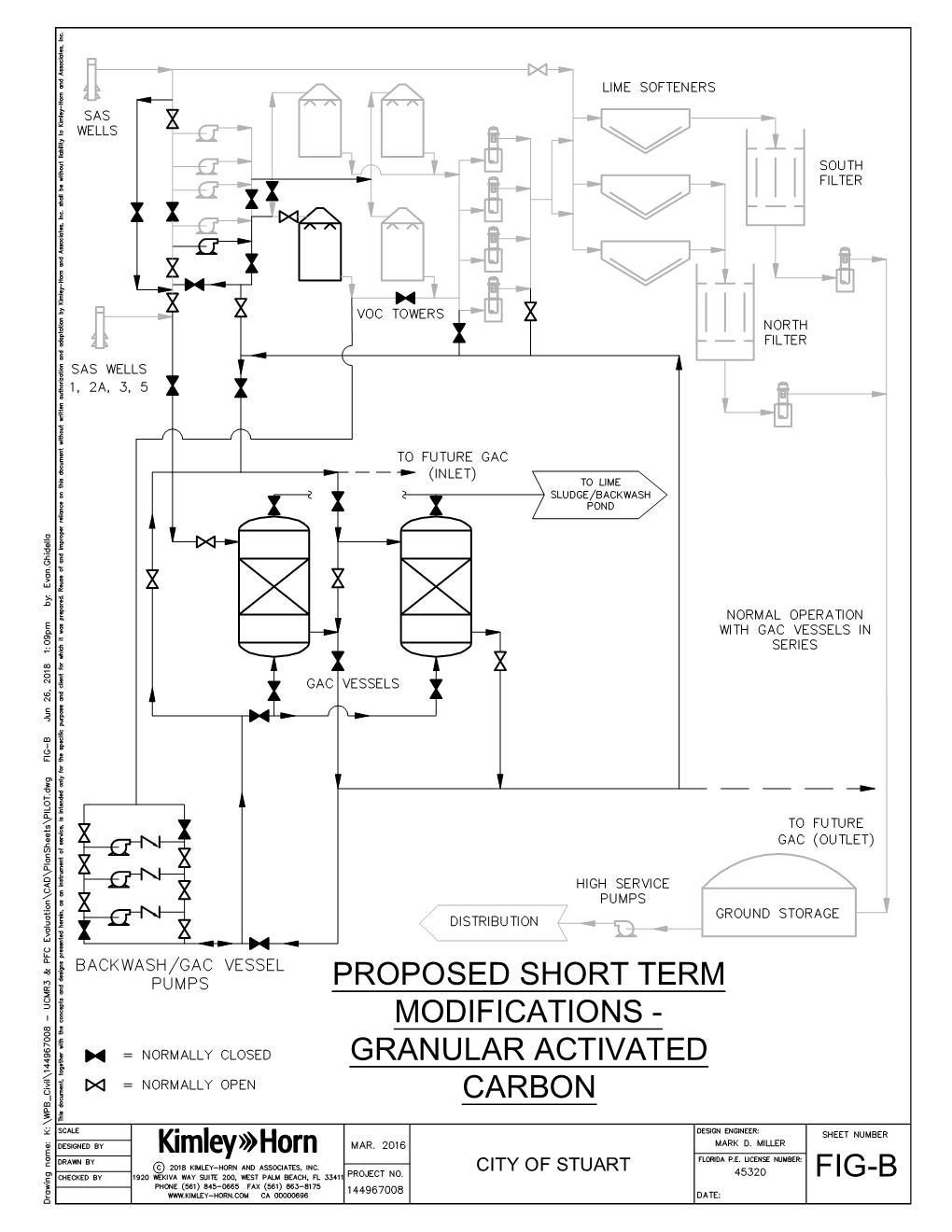
Granular Activated Carbon
Activated carbon is commonly used to adsorb natural organic compounds, taste and odor compounds, and synthetic organic chemicals in drinking water treatment. Adsorption is both the physical and chemical process of accumulating a substance at the interface between the liquid and solids phases. Activated carbon is an effective adsorbent because it’s a highly porous material and provides a large surface area where contaminants may adsorb. The two main types of activated carbon used in water treatment applications are GAC and powdered activated carbon (PAC). Further, there are other types of GAC, including coconut, wood, and coal-based.
Multiple carbon manufacturers and carbon bases (of their carbon components) have been utilized to effectively remove PFAS in water sources and the testing research has resulted in a variance of active removal rates and bed volumes. The carbon base material, loading rates, raw water contaminants, NOM and TOC, and granule size have all contributed to the length of run time, removal of specific contaminants, and regeneration frequency. Despite the variations in these criteria, the treatment technology overall is effective at removing PFAS of concern to the city. Continued on page 36
Continued from page 35 In general, waters with TOC and NOM in the raw water significantly reduce the bed volumes to contaminant breakthrough, which results in more-frequent regeneration and more-costly operations. Relating to the city’s groundwater supply, organics are going to be present and are most likely going to reduce the longevity of each carbon load. It’s anticipated that the frequency of full breakthrough would be around 10,000 bed volumes (Appleman, 2012).
At the pilot scale, small columns of GAC can be exposed to a steady stream of raw water to simulate the actual operating conditions of the utility. Pilot testing is typically completed using 4-in. columns filled with a known quantity of GAC. As the water is processed through the GAC, the water quality parameters are analyzed on the treated side of the GAC media. As the specific parameters of concern consume the GAC adsorption sites within the media, they will be identified in the treated water. This is termed as the initial breakthrough and the beginning stages of degrading removal of the specified contaminant.
At this point, the carbon will become less efficient at removing the contaminant and the engineering analysis can be used to determine the percentage of breakthrough that can be allowed, while maintaining compliance with the regulatory conditions. Once the GAC reaches its limit for obtaining regulatory compliance, it’s considered exhausted and requires regeneration or replacement with virgin media. This process reveals the design parameters for the full-scale design and operation of the GAC treatment process and can be scaled up directly to the full-scale treatment.
At full-scale treatment design and operation, the process is administered in the same fashion. The pressurized carbon vessels are much larger and hold from 20,000 to 40,000 lbs of GAC, requiring backwash cycles as the pressure buildup in the vessel typically escalates prior to the exhaustion of the carbon media. The breakthrough of the contaminants is observed similarly to the breakthrough described for the pilot-scale operation. The frequency of regeneration is similar to the process observed in the pilot scale adjusted for the quantity of flow at the full-scale treatment. As noted, the full-scale treatment and operation closely resembles the process experienced in the pilot-scale treatment and operation.
Some of the advantages of using GAC include: S Proven technology with numerous installations. S Requires low operating pressures. S No chemicals are required for treatment. S Less maintenance than other treatment alternatives. S High percentage of removal of specific contaminants. S Can be designed for full or partial removal of contaminants. S Regenerated GAC minimizes operational costs. S Capital expense for installation is low compared to other alternatives. S Allows hardness and alkalinity through for treated water stability.
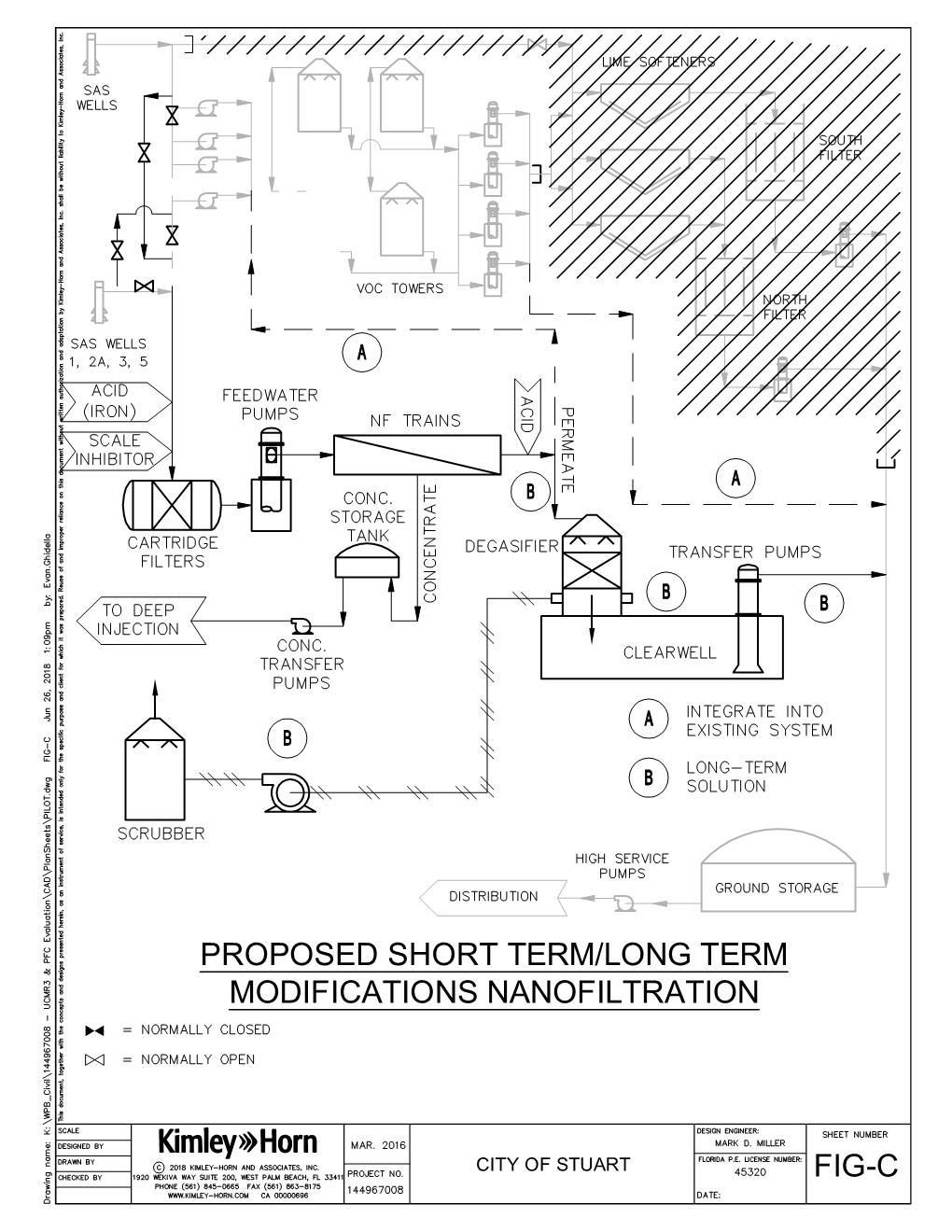
S S
S
S
The disadvantages include: Spent carbon must be regenerated offsite. GAC is consumed by hydrogen sulfide (H 2 S), iron, dissolved organic carbon (DOC), and TOC, which can reduce the removal efficiency and significantly shorten the regeneration cycles, resulting in increased operating costs. Iron can blind over the media, greatly reducing the treatment effectiveness of the GAC. Operational expenses may be higher than the other alternatives due to the frequent estimation of regeneration cycles. Continued on page 38










